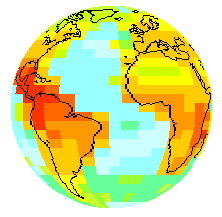![]() Measures
of biodiversity are needed to determine the 'where' of in situ conservation
action rather than the 'how', particularly in deciding which combinations
of available areas could represent and help sustain the most biodiversity
value for the future. This raises many questions, including:
Measures
of biodiversity are needed to determine the 'where' of in situ conservation
action rather than the 'how', particularly in deciding which combinations
of available areas could represent and help sustain the most biodiversity
value for the future. This raises many questions, including:
Diversity is a property of sets of organisms. These sets are usually defined by the volume of space in which they occur, although for many studies the third dimension can be ignored, so that sets can be defined by an area of land or sea.
We follow a popular approach of dividing the surface area of the world
into grid cells or polygons. For purposes other than choosing among land-management
units for conservation, equal-area (ref
10) or nearly equal-area grid cells (ref
5) are often used because they reduce the species-area effects on diversity
and rarity measures. Above all, the studies described here are assumed
to be based on unbiased knowledge of the occurrence of organisms, or at
the very least, on the best available knowledge of their distributions
(ref 5).
Biodiversity has been seen as the total (and irreducible) complexity of all life, including not only the great variety of organisms but also their varying behaviour and interactions. From this viewpoint, no single objective measure of biodiversity is possible, only measures relating to particular purposes or applications. So for conservationists, for example, a measure of biodiversity should quantify a value that is both broadly shared among the people for whom they are acting and considered as being in need of protection.
One of the more broadly shared and economically defensible values for conserving wholesale biodiversity (rather than just the few components or 'biospecifics' with obvious high use value at present) may be seen to lie in ensuring continued possibilities both for adaptation, and for future use by people in a changing and uncertain world (this is not to deny other possible values). Consequently, biologists have argued that this value in biodiversity is likely to be associated with the variety of different genes that can be expressed by organisms as potentially useful phenotypic traits or characters (different chemicals, morphological features, functional behaviour). Because we do not know yet precisely which genes or characters will be of value in the future, first they must all be treated as having equal value, and second, the greatest value for conservation will come from ensuring the persistence of as many different genes or characters as possible, as a form of insurance (ref 2, ref 3).
For example, a dandelion and a giant redwood can be seen to represent a richer collection of characters in total, and so greater diversity value, than another pair of more similar species, a dandelion and a daisy (ref 1). This shows how the phenotypic characters (or the genes that code for them) could provide a 'currency' of value for biodiversity. Pursuing this idea, we will then need to maximise richness in the character currency within the conservationists' 'bank' of managed or protected areas.
A consequence of this approach to valuing biodiversity is that it provides one possible unified view of the traditional three levels at which biodiversity has been described. In effect it uses genetic diversity as a basis for valuing both species diversity (for their relative richness in different genes) and ecosystem diversity (for the relative richness in the different processes to which the genes ultimately contribute). This provides additional justification for multi-level approaches and biodiversity-surrogate methods.
A particular strength of the single currency approach is that it avoids the problems in compound measures of trying to trade-off measures for different properties that really cannot be compared or inter-converted (such as species richness and the relative abundances among species that are combined in the diversity measures used in community ecology), which otherwise can lead to confusion and a loss of accountability. This advantage of accountability in terms of a single currency of value becomes particularly important when faced with the problem of choosing areas for biodiversity conservation, when many other factors may be involved (see the sequential approach to accommodating multiple factors).
The difficulty with this single currency approach is that the numbers of genes or characters cannot usually be counted directly, so the problem is how best to estimate them?


 |
Link to image showing a current joint work with Raino Lampinen, Tapani Lahti and Pertti Uotila of Atlas Florae Europaeae to look at patterns of diversity in European land plants. |